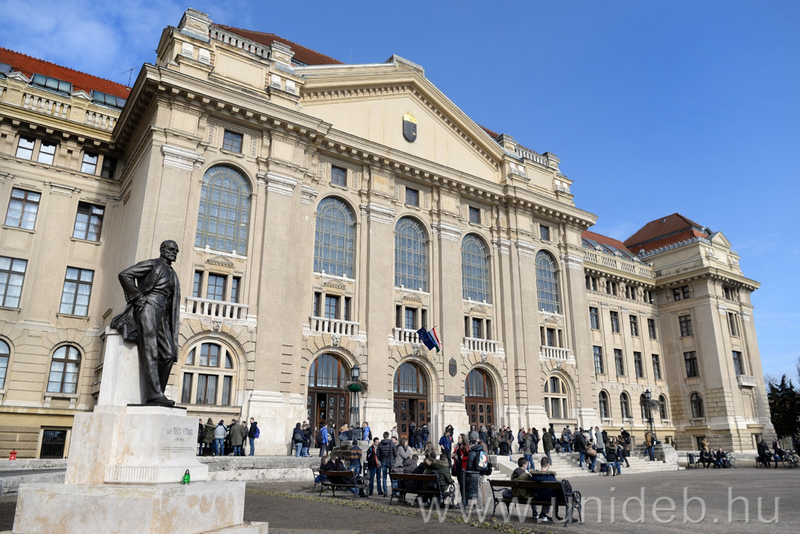Digitization is increasingly gaining ground in the construction industry as well. It will soon become commonplace on construction sites that at the end of the day, a robot and a drone will walk around the buildings, so any deviations from the plan will immediately become visible. The students of the Technical Faculty of the University of Debrecen were introduced to the new method by a guest speaker from Norway.
Hungarian-born Gábor Sziebig, associate professor of the Industrial Engineering Department of UiT The Arctic University of Norway, and project coordinator of the SINTEF Research Institute, gave a lecture to the students of the Department of Mechatronics and Civil Engineering at the Faculty of Technology of the University of Debrecen (DE MK). The renowned specialist is an IEEE Student of the DE MK Mechatronics Department, the DE MK Department of Civil Engineering, and the Institute of Electrical and Electronics Engineers IEEE Student dealing with the development of standards related to electronics, electrical engineering, and computer science, teaching, organizing scientific conferences, and publishing-related studies. He visited Debrecen at the joint invitation of Branch.
In a presentation in English, Gábor Sziebig talked about a European Union project, the essence of which is the combination of mechanical engineering and virtual reality design with the construction industry. He pointed out: a common problem on construction sites is that they deviate from the plans intentionally or due to the inattention of the workers. This sometimes results in the fact that a constructed part has to be dismantled after many days, which entails significant additional costs.
According to the new method, a digital copy of the building is created during planning. At the end of the day at the construction site, a robot and a drone walk around the building and insert the built parts into the digital copy, so any deviations become immediately visible, which the designer either accepts, then redesigns the building and the digital copy, or before continuing construction unzips the faulty part. The cost of dismantling is thus significantly reduced, which more than covers the use of the robot and the drone
– explained Gábor Sziebig.
He explained: in addition to this, it is also new that workers working on construction sites must wear trackers, so the logging of work processes is more accurate than ever before, and thus the division of responsibility between the designer and the contractor is much clearer.
Géza Husi, dean of the Faculty of Engineering of the University of Debrecen, said: such a system would also be useful for the faculty for its planned constructions in the near future, because, for example, the planned chamber for measuring electromagnetic compatibility must meet a number of special technical requirements that do not occur in normal constructions, so the chance of spoiling is quite high.
– Such guest lectures are important to us because the Faculty of Engineering of the University of Debrecen has an important goal of opening up to international scientific life as much as possible. The faculty and UiT The Arctic University of Norway are developing closer and closer relations, together we participate in various research projects and jointly edit the articles presenting their results, said the dean.
Imre Kovács, head of the Department of Civil Engineering at DE MK, explained: Gábor Sziebig’s presentation greatly contributed to expanding the student’s knowledge and broadening their horizons.
The basic novelty of the described project is that the principles of industry 4.0 and 5.0, which are already common in manufacturing, are also transferred to the construction industry. In the future, according to the vision of the Hungarian Chamber of Engineers, it is expected that BIM-based design services, coordination, and collision checks will be mandatory for some branches. Further changes are expected in this area
– Imre Kovács pointed out.
Péter Korondi, university professor of the Mechatronics Department of DE MK, added: Gábor Sziebig was once his excellent doctoral student, who, in addition to his university activities, is also the chairman of the Industrial Society Control, Robotics and Mechatronics Technical Committee operating within the IEEE international professional organization. In addition, he is also a newly elected member of the IEEE-PEMC Committee, which was created at the initiative of Hungary and brings together specialists dealing with power electronics and motion control.
I am proud of my former student. I hope that more of the students of the University of Debrecen will be able to participate in this project as a summer internship
– said Professor Péter Korondi.
The success of Gábor Sziebig’s lecture, also supported by the DAB, is a good indication that after its end, the students asked the lecturer more and more questions related to the topic for more than half an hour.
unideb.hu


















